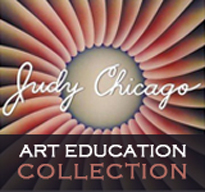FACILITATION: One facilitator described how the presentations allowed everyone knowledge about each other’s creative level. She did not want to be directive and so allowed the time to range from 15 minutes to an hour presentation. Participants, in this group, took the lead to stop their peers when time allocation for one was far greater than for the others. Other facilitators were strict time-keepers to provide equal time for all. Most facilitators took an in-between position, either asking the group to decide on the time limit to self-impose or reminded of the need to move on but still allowed some variation in time allocated to each presenter if the questions raised by the presentation were perceived by all or most as valuable. Some of the facilitators and participants (predominately the women) asked questions that brought out personal context for the art presented.
PURPOSE: The purpose of the self-presentations articulated by the facilitators included to tell the life stories that provide the context for understanding your art, to consider the preparation as self-examination of the influences that shape the art you create, and to provide a personal context or personal history for the art you present to the group. Another stated the purpose as a way to meet everyone, to learn what each hoped to gain from participation in the project, and to learn more about the artist within. One facilitator noted that women in her group “used the self-presentations as a way to search for personal connections” and there were plenty of dialogic interruptions during the presentations that contributed to both chaos and bonding of the group. Another facilitator felt it was important to make sure presenters were not interrupted during the time they were asked to present about themselves and their art.
PROCESS: Other facilitators provided guiding questions or directives, rather than posit the goal of the self-presentations, to prepare their participants. For example the photography group was asked “to start by showing your work, then give some information about yourself, and to describe why you are interested in the project.” The mural group was asked to describe “why you are here, what you are expecting, and to be honest (at least with yourself) about your agenda in the project.”
PERFORMANCE GROUP: The performance group was asked to present how they self-identify, without bringing images of their work. Gayle Fekete, the facilitator of the performance group, felt this was a way to start with an equalizer. Then for the next set of self-revealing discussion she asked the participants to describe, “how you come to your creative process and how you approach a new idea.” She did not say ,“let’s eliminate credentials” from the self-presentations, but it was understood that they were all smart and experienced performers and that this was not needed to include. In the third stage of self-presentations, Gayle asked the participants to bring something concrete that shows what they do and to discuss artists that have influenced them. At first Gayle let the time allotted for each to begin and end in an “organic flow,” but found that she needed to be a time-keeper, much to her dislike of the role, to allow a space for each in the time all were willing and able to meet together. Her group decided they needed social time together. They met at a participant’s house. While sharing food they still kept in the circle format to allow all to participate in the organic conversation. From discussion on where each is coming from, why they do what they do, and the sharing of their artwork four themes “bubbled to the surface: body, voice, time, and memory.”
PARTICIPANTS: Additionally, there was variation in how participants presented themselves. Commonly, the first presenter set the precedent used by those who are developing artists. Those more confident in their art and identity varied in both presentational style and how they discussed their art. Many female professional artists connected their personal experiences to the content of their art, while most male artists did not. One male facilitator perceived that most of the ETF project participants in his group did not acknowledge in their self-presentations that they make art derived from their personal history, nor feel that their personal history is relevant to their artmaking process.

Leave a Reply
You must be logged in to post a comment.